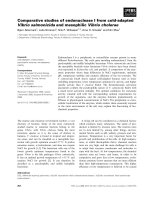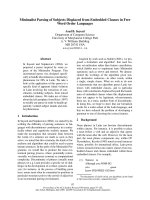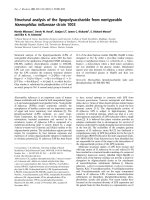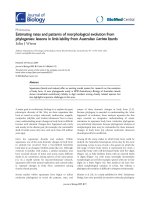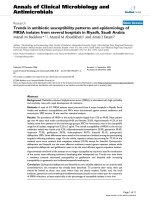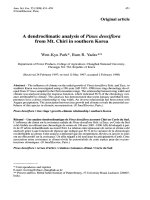Comparative casestudy of biogas utilization from livestock manure in vietnam focussing on CO2 balance
Bạn đang xem bản rút gọn của tài liệu. Xem và tải ngay bản đầy đủ của tài liệu tại đây (1.38 MB, 88 trang )
TRƯƠNG THỊ KIM DUNG
COMPARATIVE CASE STUDY OF BIOGAS UTILIZATION FROM
LIVESTOCK MANURE IN VIETNAM
(FOCUSSING ON CO2 BALANCE)
Field: waste management and contaminated site treatment
MASTER THESIS
Supervisor:
Dr.-Ing. Christoph Wünsch
Dresden, September, 2011
ACKNOWLEDGEMENT
Firstly I would like to thank to the Hanoi University of Science, Vietnam
National University and Techniche Universtät Dresden, Institute of Waste
Management and Contaminated Site Treatment, whose have established a good study
program for us to learn a good new field of environment.
I would like to thanks to Prof. Bernd Bilitewski, Prof. Nguyen Thi Diem Trang
and Dr. Hoang Van Ha, whose always keep an eye on our study and help us so much.
My sincerely thanks to my supervisor Dr. Christoph Wünsch, Dipl. Veit
Grundmann , who guide and help me hold-heartedly during the time I did the thesis.
And I also want to thanks to Dr. Catalin Stephan and Dipl.Hoang Mai. I still remember
our discussion, small parties as well as your encouragements. It helps me more selfconfident in my ability.
Finally I want to thanks so much to my family. You are my motivation to
overcome difficulties in my life.
ABSTRACT
From 2003 Livestock Production Department under Ministry of Agriculture and
Rural Development - MARD cooperates with Netherlands Development Organization
– SNV to deploy of domestic biogas program for livestock production in rural area.
The program not only solve environment problems in terms of pollution and
improve rural life quality, it also contributes to greenhouse gas reduction considerably.
At household scale, biogas is utilized mostly for cooking and such tons of
greenhouse gas can be reduced from one household per year, mostly from correct
livestock manure management and fossil fuel substitution.
At farm scale, biogas can be utilized for electricity generation, thousands KWh
of electricity can be produced and such thousand tons of greenhouse gas can be
reduced per farm per year.
It should be encouraged to apply this treatment method for all kinds of livestock
of the country. The greenhouse gas emission reduction will be much more
significantly, contribute to meet the aim of the Kyoto Protocol “to achieve stabilization
of atmospheric concentration of greenhouse gases at a level that would prevent
dangerous anthropogenic interference with the climate system” that Vietnam signed in.
Contents
INTRODUCTION ............................................................................................................ 6
I.
BACKGROUND ....................................................................................................... 1
1.1. Greenhouse effects and climate change ............................................................. 1
1.1.1. Greenhouse effects .......................................................................................... 1
1.1.2.
Climate change ............................................................................................ 3
1.2.
Greenhouse gas emission situation in Vietnam.............................................. 7
1.3.
Livestock growing situation in Vietnam .......................................................... 12
II. OVERVIEW ON BIOGAS ..................................................................................... 16
2.1.
Scientific theory of anaerobic digestion (biogas formation) ....................... 16
2.2.
Composition of biogas .................................................................................... 19
2.3.
Substrates for anaerobic digestion ................................................................ 22
III.
BIOGAS PROJECT IN VIETNAM .................................................................... 22
3.1. Project overview ................................................................................................. 22
3.2. Technology of anaerobic digester used in the project .................................... 23
3.2.1. Structure of the anaerobic digester ................................................................ 23
3.2.2. Operation of the biogas plant ........................................................................ 25
3.2.3. Treatment efficiency of biogas plants ........................................................... 26
3.3. Utilization of outputs from biogas plants ............................................................ 27
3.3.1. Utilization of biogas ...................................................................................... 27
3.3.2. Utilization of bio-slurry ................................................................................. 31
IV. CASE STUDY ......................................................................................................... 35
4.1. Project scenario .................................................................................................. 35
4.2. Methodology ....................................................................................................... 36
4.2.1. GHG reduction from manure management ................................................... 36
3.2.2. GHG reduction from the fossil fuel substitution in thermal application or
electricity generation ............................................................................................... 42
3.2.3. GHG reduction from chemical fertilizer substitution by bio-slurry.............. 46
4.3. Calculation and results ...................................................................................... 48
4.3.1. GHG reduction at household scale ................................................................ 48
4.3.2. GHG reduction at farm scale ......................................................................... 64
4.4. Outlook ............................................................................................................... 67
IV.
CONCLUSION .................................................................................................... 71
ABBREVIATION
bn
Billion
e
equivalent
DM
Dry matter (%
Ho,n
Calorific value (kWh/Nm3)
Hu,n
Calorific value (kWh/Nm3)
IPCC
Intergovernmental Panel on Climate Change
GHG
Greenhouse gas
LFG
Landfill gas
MARD
Ministry of agriculture and rural development
MNVOC
Non-methane volatile organic compounds
SNV
The Netherlands development organization
VS
Volatile solid
UNFCCC
United Nations framework Convention on Climate Change
or
g/l)
LIST OF TABLES
Table 1: National greenhouse gas emission inventory by sector of Vietnam in 2000 ..... 7
Table 2: greenhouse gas emission from agriculture sector .............................................. 8
Table 3: total primary energy consumption by type of energy ........................................ 9
Table 4: GHG emission from fuel combustion by type of fuel in 2000 ........................ 10
Table 5: GHG emission from fuel combustion by sub-sector ....................................... 10
Table 6: GHG emission from fuel combustion by type of gas ...................................... 11
Table 7: Livestock population growth (thousands)........................................................ 13
Table 8: livestock and milk production, million metric tons ......................................... 14
Table 9: total livestock waste (solid) generation in 2006 .............................................. 16
Table 10: Environmental requirements .......................................................................... 19
Table 11: Biogas composition ........................................................................................ 19
Table 12: Biogas composition compared with natural gas ............................................ 20
Table 13: General energy characteristics of biogas ....................................................... 21
Table 14: Treatment efficiency of biogas plants ............................................................ 26
Table 15: Limited parameters for surface water quality according to the National
technical regulation 2008 ............................................................................................... 27
Table 16: comparative values of biogas and other fuels ................................................ 28
Table 17: consumption of biogas and kerosene fuel in lighting according to the
experience of the Institute of Energy ............................................................................. 30
Table 18: Nutrient concentrations in the bio-slurry ....................................................... 32
Table 19: concentration of some heavy metals in bio-slurry ......................................... 33
Table 20: nutrient contents in compost fertilizer made from bio-slurry and agricultural
waste ............................................................................................................................... 34
Table 21: benefits from application of bio-slurry in agriculture in some provinces ..... 35
Table 22: input parameters for methane emission calculation from the baseline scenario
(unrecoverable anaerobic lagoon) .................................................................................. 49
Table 23 input parameters for indirect nitrogen oxide emission calculation from the
baseline scenario (unrecoverable anaerobic lagoon) and project scenario (biogas plant)
........................................................................................................................................ 51
Table 24: result of GHG emission reduction from manure management ...................... 52
Table 25: combustion efficiencies of combustion equipments with different fuels ...... 53
Table 26: GHG emission factor of coal ......................................................................... 54
Table 27: input parameters for GHG emission reduction calculation from fuel
substitution in thermal application for at household scale. ............................................ 54
Table 28: GHG reduction results for a household growing 6 pigs ................................ 56
Table 29: Emission factors for stationary combustion in the residential and
agricultural/forestry/fishing/farms ................................................................................. 58
Table 30: Results of GHG reduction in case different fossil fuel used in absence of the
project ............................................................................................................................. 59
Table 31: GHG emission reduction according to population of livestock (pig) ............ 61
Table 32: the utilized biogas yield according to population of livestock (pig) ............. 63
Table 33: GHG reduction for a farm growing 100 pigs with utilization of biogas for
electricity generation ...................................................................................................... 66
Table 34: input parameters for GHG emission reduction calculation from biogas
destruction in the outlook ............................................................................................... 67
Table 35: The result of GHG emission reduction from biogas destruction in the outlook
........................................................................................................................................ 68
Table 36: input parameters for GHG emission reduction calculation from nitrogen
oxide emission reduction in the outlook ........................................................................ 68
Table 37: The result of GHG emission reduction from nitrogen emission reduction in
the outlook ...................................................................................................................... 69
Table 38: The result of GHG emission reduction from manure management in the
outlook ............................................................................................................................ 69
Table 39: input parameters for GHG emission reduction calculation fuel substitution in
thermal application in the outlook.................................................................................. 70
Table 40: GHG emission reduction calculation fuel substitution in thermal application
in the outlook.................................................................................................................. 70
Table 41: Total GHG emission reduction in the outlook ............................................... 71
LIST OF CHARTS
Chart 1: GHG reduction for a household growing 6 pigs with utilization of biogas for
cooking purpose ............................................................................................................. 57
Chart 2: GHG reduction in case different fossil fuel used in the absence of the project
........................................................................................................................................ 60
Chart 3: GHG emission reduction according to number of livestock ............................ 62
Chart 4: GHG reduction for a farm growing 100 pigs with utilization of biogas for
electricity generation ...................................................................................................... 66
LIST OF FIGURES
Figure 1: The greenhouse effect principle ....................................................................... 3
Figure 2: changes in temperature, sea level and Northern Hemisphere snow cover ....... 5
Figure 3: National greenhouse gas emission inventory by sector of Vietnam in 2000 .. 8
Figure 4: Growth rate of pork production ...................................................................... 15
Figure 5: the anaerobic digestion process ...................................................................... 18
Figure 6: Types of fixed dome biogas plant used in the project are KT1 and KT2 ...... 24
Figure 7: two limit stages of fixed dome plant .............................................................. 25
Figure 8: diagram of biogas burner ................................................................................ 27
Figure 9: Structure of biogas lamp ................................................................................. 29
Figure 10: A biogas water boiler device ........................................................................ 31
Figure 11: Project scenario............................................................................................. 35
Figure 12: baseline scenario boundary of GHG reduction source: biogas destruction . 38
Figure 13: project scenario boundary of GHG reduction source: biogas destruction ... 39
Figure 14: Baseline scenario boundary of GHG reduction source: fossil fuel
substitution in thermal application ................................................................................. 43
Figure 15: project scenario boundary of GHG reduction source: fossil fuel substitution
in thermal application ..................................................................................................... 43
Figure 16: Baseline scenario boundary of GHG reduction source: fossil fuel
substitution in electricity generation .............................................................................. 44
Figure 17: Project scenario boundary of GHG reduction source: fossil fuel substitution
in electricity generation .................................................................................................. 45
Figure 18: baseline scenario boundary of GHG reduction source: chemical fertilizer
substitution ..................................................................................................................... 47
Figure 19: project scenario boundary of GHG reduction source: chemical fertilizer
substitution ..................................................................................................................... 47
INTRODUCTION
Above the environment pollution problems from the rapid growing in livestock
production without livestock manure treatment, the situation of lack of energy, and the
overuse of chemical fertilizer production for crop production. From 2003 Livestock
Production Department under Ministry of Agriculture and Rural Development MARD cooperates with Netherlands Development Organization – SNV to deploy of
domestic biogas program to solve the short term of environment problems and also
have the long term objective of improving the livelihood and quality of life of rural
farmers in Vietnam.
Until now there are more than 106000 biogas systems constructed in over 50 provinces
nationwide, millions tons of livestock manure are treated. There are also some
evaluation reports on economical and social effects. But there isn’t any detail report
evaluating on environmental effects, especially greenhouse gas reduction from that
project.
The aim of this research is the detail assessment of GHG emission balance from
livestock manure treatment method by anaerobic digesters (biogas plants) in the project
to provide the reference data about the benefits of that project in term of GHG emission
balance.
I.
BACKGROUND
1.1. Greenhouse effects and climate change
1.1.1. Greenhouse effects
“The greenhouse effect is a process by which thermal radiation from a planetary
surface is absorbed by atmospheric greenhouse gases, and is re-radiated in all
directions. Since part of this re-radiation is back towards the surface, energy is
transferred to the surface and the lower atmosphere. As a result, the temperature there
1
is higher than it would be if direct heating by solar radiation were the only warming
mechanism” />From 1827, Joseph Fourier recognized the importance of the greenhouse effect
for the Earth’s climate. He emphasized that the atmosphere is relatively transparent to
solar radiation, but highly absorbent to thermal radiation and that this preferential
trapping is responsible for raising the temperature of the Earth’s surface [Isaac M.
Held, Brian J. Sodden, 2000]. “The natural greenhouse effect means the short-wave
energy from the sun is absorbed at the earth’s surface and reradiated in the form of
infrared Chart (long wave) radiation. The greenhouse gas (some of low concentrate
gases in atmospheric notably CO2, CH4, NOx, CO, etc.) absorb and emit long wave
radiation. The increase in the atmospheric concentration of GHG leads to an
incremental absorption and emission of long-wave radiation. All of them would result
in a warming of the lower atmosphere and the surface of earth. This effect is referred as
“greenhouse effect”. Human beings and most other living creatures can not survive
without Natural greenhouse effect. The greenhouse effect keeps the temperature of
biosphere stable and filters some harmful radiations and hence protects the ecological
system” [Jia Xiaodong, 2009]
Because of influence from human activities, greenhouse gas is increased,
leading to enhanced greenhouse effect and climate change. Expressions of the climate
change include temperature change in global scale, sea level rise, precipitation change
and the increase of extreme weather events [IPCC, 2008].
2
Figure 1: The greenhouse effect principle
Source: />1.1.2. Climate change
* Definitions of climate change
The definitions of climate change are different of the Intergovernmental Panel
on Climate Change (IPCC) and the United Nations Framework Convention on Climate
Change (UNFCCC).
According to IPCC, “the climate change refers to a change in the state of the
climate that can be identified (e.g. using statistical tests) by changes in the mean and/or
the variability of it property, and that persists for an extended period, typically decades
or longer. It refers to any change in climate over time, whether due to natural
variability or as a result of human activity”.
3
The climate change according to UNFCCC is a change of climate that is
contributed directly or indirectly to human activity that alters the composition of the
global atmosphere and that is in addition to natural climate variability observed over
comparable time periods [IPCC, 2008]
* Climate change over the world
Global warming is now evident from increases of global air, ocean temperatures
and widespread melting of ice and snow and rising global sea level.
According to the instrument record of global surface temperature from 1850, the eleven
years of the rank from 1995 to 2006 is the warmest years [IPCC, 2008].
The linear trend of the global average temperature in the same long period of
100 years from 1906 to 2005 is 0.74 [0.56 to 0.92], higher than the 100-year period
from 1901 to 2000 that is 0.6 [0.4 to 0.8]. The linear warming trend over the 50 years
from 1956 to 2005 (0.13 [0.10 to 0.16]°C per decade) is nearly twice higher than the
period of 100 years from 1906 to 2005. [IPCC, 2008]
4
Figure 2: changes in temperature, sea level and Northern Hemisphere snow cover
Source: [IPCC, 2008]
The temperature increase has taken place at global scale. The increase rate of
temperature in Acrtic is almost twice higher than the global average rate in the past 100
years. Land regions are warmed faster than the oceans.
The increase of sea level is correlative with warming of the earth (figure 2). The
sea level rose have been clearer in recent years. The global sea level rise rate from
1993 to 2003 is 3.1 [2.4 to 3.8] mm per year that is higher than the rate of 1.8 [1.3 to
2.3] of the period from 1961 to 2003 [IPCC, 2008]. That increase is contributed by the
5
thermal expansion of the oceans (57%), by the decreases in glaciers and ice caps (28%)
and losses from polar ice sheets (15%) [IPCC, 2008].
The decreases of snow and ice are also relative with warming of the earth
(figure 2). The annual average sea ice in Arctic has shrunken about 2.7 [2.1 to 3.3]%
per decade, and this number is higher in summers of 7.4 [5.0 to 9.8]% per decade.
Glaciers and snow in mountains in both hemispheres also have declined. The frozend
ground extent in the Northern Hemisphere has decreased about 7% since 1900. From
the 1980s up to now, the temperature at the top of the permafrost layer in Arctic
increased by up 3°C [IPCC, 2008].
The precipitate also changed much in many regions. “Globally, the area affected
by drought has likely increased since the 1970s”. [IPCC, 2008]
The extreme changes of the weather have happened frequently over the last 50
years: “it is very likely that cold days, cold nights and frosts have become less frequent
over most land areas, while hot days and hot nights have become more frequent. It is
likely that heat waves have become more frequent over most land areas. It is likely that
frequency of heavy precipitation events has increased over most areas. And it is likely
that the incidence of extreme high sea level has increased at abroad range of sites
worldwide since 1975”[IPCC, 2008].
The average temperature in the Northern Hemisphere during the second half of
the 20th century is higher than any 50-year period in the last 500 years and is the
highest in at least past 1300 years [IPCC, 2008].
* Climate change in Vietnam
Vietnam is one of the countries that are suffered mostly of climate change.
According to recent studies in Vietnam, the average temperature has increased about
0.1 10C per decade. The weather seems severer. The temperature of beginning months
of the winter decreases but increases in months of the end of the winter. Seasonal
rainfall decreases in July and August and increases in September, October and
6
November. The sea level has risen at average rate about 2.5 – 3 cm per decade. Storms,
floods and droughts have taken more frequently recent years.
Because of the climate change, the sea water level of Vietnam is forecasted to be
raised by 33 cm in 2050 and 45 cm in 2070. And if the sea level increases up to 90 cm
in 2100, a huge area in the Red River Delta, north central coastal area and Cuu Long
delta area will be submerged under water [MARD, SNV, 2007].
1.2.
Greenhouse gas emission situation in Vietnam
Vietnam has contributed around 151 million tons of CO2 equivalent in 2000 in
which agriculture sector is the largest source (43.1%), then is from the energy sector
(35.0 %) and at least from industrial sector (6.6 %) and from waste (5.3 %) as in the
table 1 and figure 3.
Table 1: National greenhouse gas emission inventory by sector of Vietnam in 2000
CO2
Sector
CH4
N2 O
(thousand (thousand (thousand
CO2e
(thousand
Percentage
(%)
tons)
tons)
tons)
tons)
Energy
45,900.00
308.56
1.27
52,773.46
35.0
Industrial processes
10,005.72
0
0
10,005/72
6.6
0
2,383.75
48.49
65,090.65
43.1
11,860.19
140.33
0.96
15,104.72
10.0
Waste
0
331.48
3.11
7,925.18
5.3
Total
67,765.91
3,164.12
53.83
150,899.73
100
Agriculture
Land use, land-use
change and forestry
7
Source: [MONRE, 2010]
Figure 3: National greenhouse gas emission inventory by sector of Vietnam in 2000
Source: [MONRE, 2010]
In agriculture sector, sources of GHG emission are from rice cultivation, from
livestock, agricultural soils and burning of agricultural residues as in the table 2.
Table 2: greenhouse gas emission from agriculture sector
Sector
Enteric fermentation
Manure management
Rice cultivation
Agricultural soils
Burning of savannas
Burning of agricultural
residues
Total
CO2
CH4
N2 O
CO2e
Percentage
(thousand (thousand (thousand (thousand
(%)
tons)
tons)
tons)
tons)
368.12
7,730.52
11.9
164.16
3,447.36
5.3
1,782.37
37,429.70
57.5
45.87
14,219.70
21.8
9.97
1.23
4.46
590.67
0.9
59.13
1.39
50.28
1,672.63
2.6
2,383.75
48.49
54.74
65,090.65
100
Source: [MONRE, 2010]
In energy sector, the table 3 shows the increasing primary energy consumption
in recent years due to increasing energy demand.
8
Table 3: total primary energy consumption by type of energy:
Unit: kilo tons of oil equivalent
Year
2000
2001
2002
2003
2004
2005
2006
2007
Coal
4,372
5,024
5,517
6,562
7,344
8,376
9,045
9,736
7,917
8,415
9,616
10,490 12,082 12,270 12,184 14,234
Gas
1,441
1,566
2,151
2,776
4,255
4,908
5,239
5,976
Hydropower
4,314
5,573
5,569
4,422
4,141
3,835
4,619
5,179
Gasoline and
Oil
Noncommerical
14,191 14,297 14,399 14,694 14,734 14,794 14,860 14,870
energy
Imported
electricity
Total
0
0
0
0
0
33
83
226
32,235 34,875 37,252 38,944 42,556 44,216 46,030 50,221
Source: [MONRE, 2010]
Sources of GHG emission in energy sector are from fuel combustion, fugitive
emission in course of extraction and transportation, in which mostly from fuel
combustion that is 45.9 million tones of CO2, 68.4 thousand tones of CH4 and 1.27
thousand tones of N2O in 2000 as in the table 4, the table 5 and the table 6.
9
Table 4: GHG emission from fuel combustion by type of fuel in 2000
Unit: thousand tons
Fuel
CO2
CH4
N2O NOx
CO
NMVOC
CO2e
Oil
25,426.30
1.65
0.13
145.26
485.10
92.63
25,501.25
Coal
17,879.70
4.65
0.26
49.78
69.90
7.67
18,057.95
Gas
2,607.10
0.04
0.01
5.34
0.71
0.18
2,611.04
Biomass
-
62.02
0.87
21.86
1,053.45
123.91
1,572.12
Total
45,913.11
68.36
1.27
222.24
1,609.16
224.39
47,742.36
Source: [MONRE, 2010]
Table 5: GHG emission from fuel combustion by sub-sector
Unit: thousand tons
Sub-sector
CO2
CH4
N2 O
NOx
CO
NMVOC
Energy industries
11,174.15
0.15
0.09
24.92
2.05
0.54
Manufacturing
Industries/construction
15,020.36
1.47
0.20
33.90
42.37
2.81
Transportation
11,886.00
1.41
0.10
125.08
472.82
90.11
Commercial/
Institutional
2,975.56
0.22
0.03
2.23
30.51
3.07
Residential
2,314.27
64.70
0.84
21.95
1,047.43
125.30
Agriculture/
forestry/
Aquaculture
1,373.03
0.40
0.01
14.15
13.99
2.57
Others
1,174.63
0
0
0
0
0
Total
45,900.00
68.35
1.27
222.23
1,609.17
224.40
Source: [MONRE, 2010]
10
Table 6: GHG emission from fuel combustion by type of gas
GHG emission
CO2e
Gas
Percentage
(thousand tons)
(thousand tons)
CO2
45,900.00
45,900.00
96.2
CH4
68.35
1,435.35
3.0
N2 O
1.27
393.70
0.8
47,729.05
100
Total
Source: [MONRE, 2010]
Vietnam has been a part of UNFCCC and signed the Kyoto Protocol on 25th,
September 2002 with the aim “to achieve stabilization of atmospheric concentration of
greenhouse gases at a level that would prevent dangerous anthropogenic interference
with the climate system”.
Related to the aim of greenhouse gas reduction in the Kyoto Protocol, Vietnam has
had a number of environment protection laws and regulations including:
Environmental Protection Law No. 52/2005/QH11 dated 29th November 2005
Water Resources Law No. 08/1998/QH10 dated 20th May 1998.
Petroleum Law (1993) No. 10/2008/QH12 dated 6th July 1993 (amended twice
on 9th June 2000 and 3rd June 2008).
Law on Minerals No. 2/1996/QH9 dated 1st September 1996 (amended on 27th
June 2005).
Law on Forest Protection and Development No. 29/2004/QH11 dated 3rd
December 2004 (replaces the 1991 Law on Forest Protection and Development).
Law of Electricity No. 28/2004/QH11 dated 3rd December 2004.
11
Law on Safe and Efficient Use of Energy No. 50/2010/QH12 dated 28th June
2010.
Vietnam also has had the national strategies and programs related to GHG
reduction. The National Environment Protection strategy 2003 aims to apply of clean
technologies, cleaner production processes and use of environment-friendly fuels and
materials. The National Target Program 2006 enforces on regulations on energy
conservation and efficiency. And the National Target Program 2008 to respond to
climate change, in which the development and implementation of GHG reduction
options contributes an important role in this program. Replace cooking coal by biogas
is one of options of the Government towards to reduce GHG emission.
1.3.
Livestock growing situation in Vietnam
Vietnam is on the trend of development, which the increasing growth rate in GDP
is stable around 6.5 percent from 1998 to 2003. Although the agriculture just
contributes 20% to of GDP in 2007, but Vietnam is still an agricultural country, most
of the population lives based on agriculture production. The livestock production
contributes 20% to agricultural GDP [General Statistic Office of Vietnam, 2007, 2008].
The main types of livestock are swine, cattle, buffalo and poultry. The table 7 shows
the livestock production growth from 2000 to 2010, in which the pig population is most
and increase continuously fast from 20,194 to 26,701 thousands of heads.
12
Table 7: Livestock population growth (thousands)
Goats,
Year
Pig
Cattle
Buffalo
Poultry
2000
20,194
4,128
2,897
196,100
544
127
2001
21,800
3,900
2,808
218,000
572
113
2002
23,170
4,063
2,815
233,300
622
111
2003
24,885
4,394
2,835
254,600
780
113
2004
26,144
4,908
2,870
218,200
1,023
111
2005
27,435
5,541
2,922
219,900
1,314
111
2006
26,855
6,511
2,921
214,600
1,525
87
2007
26,560
6,725
2,996
226,000
1,778
104
2008
26,701
6,338
2,898
248,000
-
-
2009
27,628
6,103
2,887
280,000
-
-
27,313
5,916
2,913
300,000
-
-
2010
(preliminary)
Sheep
Horses
Source: [General Statistic Office of Vietnam, 2007, 2008, 2010]
Vietnam is also one of countries which export mostly pork over the world (2.55
million metric tons in 2008). The table 8 shows product productions from livestock, in
which pork is the most significant contributor (71% of total livestock production).
13
Table 8: livestock and milk production, million metric tons
Products
Buffalo, live
weight
Cattle, live
weight
Milk
Pigs, live weight
Slaughtered
poultry
2003
2004
2005
2006
2007
53,061
57.458
59,800
64,317
67,507
107,540
119,789
142,163
159,463
206,145
126,697
151,314
187,679
215,953
234,438
1,795,000
2,012,000
2,288,000
2,505,000
2,553,000
372,721
316,409
321,890
344,400
358,800
Source: [General Statistic Office of Vietnam, 2008]
The figure 4 shows the fast increasing growth rate of pork production from 2003
to 2007
14
